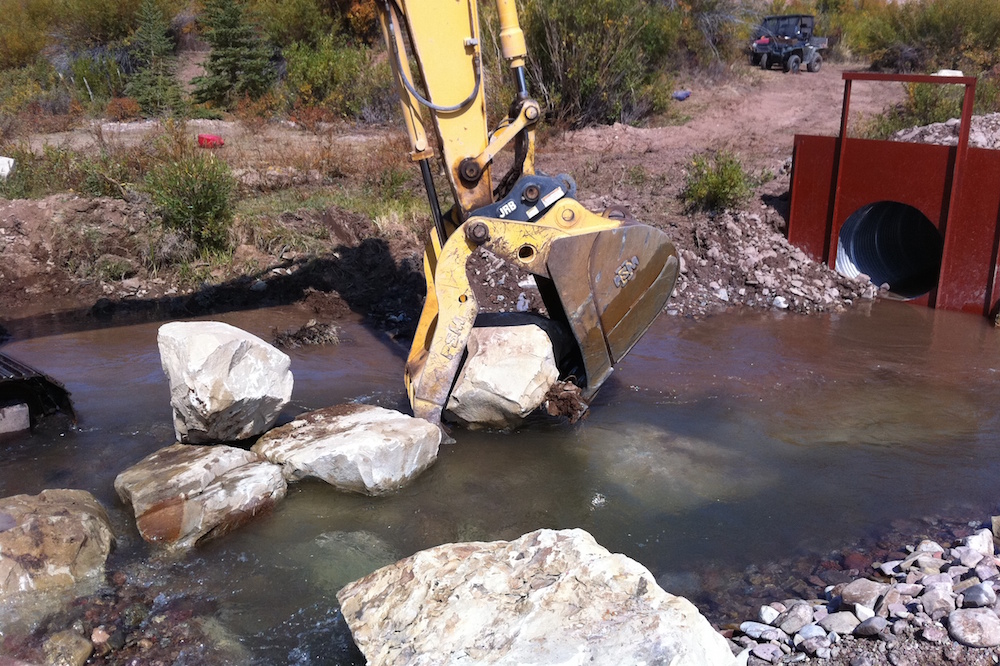How to restore a river

The goal of river restoration is a reconnected stream, free from all the homegrown structures that inadvertently inhibit the natural movement of fish, water and sediment.
The method is connecting people.
It’s tricky.
Not the hydrology, geomorphology, engineering or construction. Sure, that all takes serious expertise, and a fair bit of heavy lifting, but in the end, it’s straightforward math and muscle.
Because, while one can divert water into an irrigation ditch any number of ways — tarps, pylons, tree trunks, tractor tires, junk cars, repurposed fencing, improvised gravel bars — and clearly the ranching mainstays of elbow grease and ingenuity have served for generations, some systems are objectively better than others.
A properly engineered rock vane structure, for example, can move the necessary water through a headgate while also maintaining a year round channel that allows trout to go about their business, aquatic microlife (the foundation of the riparian ecosystem) to thrive, banks to stay put, and sediment to flush downstream. Not only that, such a setup doesn’t need to be rebuilt each year or tinkered with throughout the irrigation season. You set it and forget it. Everyone wins… or should.
The human elements of the process, though, are nowhere near so predictable.
Like religion, politics or money, water in Wyoming isn’t a topic one raises casually in polite conversation.
“Water is emotional,” explains Hillary Walrath, Trout Unlimited’s salinity control program coordinator for the Henry’s Fork of the Green River — a waterway near the Utah-Wyoming border. Water is life, and livelihood and independence for ranching families. The occasional ditch-rights shooting-match isn’t such a distant element of our history.
So tread lightly. As Nick Walrath, TU’s Green River project manager, knows, leading with “Hi, I’m from a national conservation organization and I’ve been eyeing your diversion dam…” will score you a quick escort to the gate and a firm suggestion that you not return.
It’s better to let your work speak for itself. Let an upstream neighbor mention what a relief it is to leave the excavator in the equipment shed each summer. Let the downstream neighbor share pictures of her proud grandson’s trout.
In this way the human connections that make restoration possible will have already started to form when word of the price tag — free — reaches the landowner. They’ll reach out to you.
In fact, word of mouth of work well done is, arguably, TU’s most effective tool, enabling the conservation group to restore and reconnect about 1,500 miles of stream around Wyoming in the last decade.
The resulting credibility also eases misgivings when it comes time to introduce more links — engineers, contractors, material suppliers, agencies and, of course, funders — into the relationships chain.
Projects can cost anywhere from a few thousand dollars into the millions. You’ll need to raise it from a collection of local outfits like the Wyoming Wildlife and Natural Resources Trust, Wyoming Land Conservation Initiative, DEQ, conservation districts and TU chapters; and stranger bedfellows too, like environmental groups and federal agencies. Such funds aren’t offered, or accepted, without a great deal of trust.
So be the glue, be true to your word and get it right.
Remain mindful that a stream can connect, like an artery, or divide, like a border. A single relationship may determine which it will be.
Go the extra mile. It might connect a hundred.
**This story originally appeared on WyoFile.com as an installment of Matthew’s “Wyoming Know How” series — a weekly window into the lives of everyday Americans, and an intimate glimpse of the unique experiences that define our communities, culture and life in the rural Northern Rockies. For more — check out the series here. Photo by Nick Walrath.**

